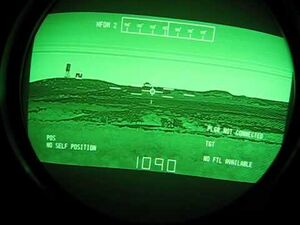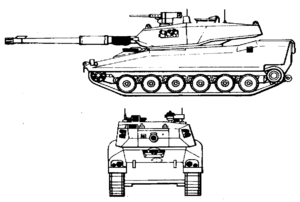PaVå-35
| PaVå-35 | |
|---|---|
 | |
| Type | Airborne Light tank |
| Place of origin | |
| Service history | |
| Used by | |
| Production history | |
| Designer | Vangsness Forsvarsfirma |
| Designed | 1984-1989 |
| Manufacturer | Vangsness Forsvarsfirma |
| Produced | 1991-Present |
| Specifications | |
| Weight | 19.8 tonnes (21.8 short tons; 19.5 long tons) |
| Length | 8.61 metres (28 ft 3 in) gun forward
6.2 metres (20 ft 4 in) hull length |
| Width | 2.69 metres (8 ft 10 in) |
| Height | 2.35 metres (7 ft 9 in) |
| Crew | 4 (commander, gunner, loader, driver) |
| Armor | Welded Aluminium and high hardness steel |
Main armament | 1 x Alban Arsenal KjK-20 105mm L/52 rifled cannon |
Secondary armament | 1 x KjMg-73 coaxial chain gun
1 x InMg-43 or InMg-74 machine gun (Optional) |
| Engine | 9.0L V6 turbo-diesel engine 552 hp |
| Power/weight | 28 hp/tonne |
| Suspension | torsion bar |
| Ground clearance | 410 millimetres (1 ft 4 in) |
| Fuel capacity | 570 L (150 US gal) |
Operational range | 483 km (300 mi) |
| Speed | 70 km/h (43 mph) |
The PaVå-35 is a Trinovantan airborne light tank designed and produced by Vangsness Forsvarsfirma to supplement the AmPaVå-26 in Trinovantan rapid deployment forces.
Development
In the early 1980s, the Trinovantan Army was convinced of the need of a heavier air-transportable fire support vehicle for use in rapid deployment forces. At the time, airborne forces could only rely on the AmPaVå-26 and other variants of the Universal Light Chassis for this role, and the aging 8 tonne platform was deemed to be insufficiently armed and armored for the direct fire support role in the modern era. To address these concerns, the Trinovantan military held an open competition under the Next Generation Light Armoured Vehicle (NGLAV) program to replace the AmPaVå-26. Requirements for the NGLAV's light tank were stringent; it could weigh no more than 20 tonnes, must fit within all currently in-service transport aircraft, had to be at least as mobile as the ULC vehicles it was to replace, had to be resistant to up to 20mm autocannon fire along the frontal axis, and it had to mount either the KjK-20 105mm rifled cannon or the KjK-55 120mm rifled cannon for ammunition commonality.
In 1986, NGLAV physical trials began. Of the 13 proposals originally submitted at the start of the program, five viable prototypes were available for testing. At the conclusion of these trials, three vehicles were discarded as not sufficiently meeting the standards of the NGLAV program. The other two vehicles that remained were determined to meet the standards as set by the program, but had other faults that must be corrected. The Vangsness proposal, while conforming to the original size restrictions, was shown to be too large to safely transport within some of the smaller transport aircraft in service with the Trinovantan military. The other proposal from the Harstad Defense Company, which had opted to use the more powerful KjK-55 modified with an automatic loader, suffered from issues with the recoil from firing its cannon. A second round of trials were scheduled for 1989 in order to test more refined variations of the two proposed vehicles.
In preparation for the 1989 trials, the Harstad proposal underwent a series of modifications. The turret was lengthened to accept a new hydro-pneumatic recoil damper, the cannon was fitted with a newly designed muzzle brake, and the torsion bar suspension was replaced with an advanced active hydropneumatic suspension. The Vangsness proposal received a slightly modified hull which set the original proposal's turret slightly deeper into the hull and at a 3 degree forward tilt. This modification allowed the Vangsness proposal to meet the new size requirements set for the 1989 trials. When the trials began, the Harstad proposal held a clear advantage over the Vangsness proposal in all fields except for crew protection and ease of maintenance, where the Vangsness proposal held a slight and significant advantage respectively. However, the modifications made to the Harstad proposal had also significantly increased the projected production and maintenance costs of the vehicle. Due to these factors, the Vangsness vehicle was selected for service.
Design
Armament
The primary armament of the PaVå-35 is Alban Arsenal's KjK-20 rifled cannon. When selected for use on the PaVå-35 the KjK-20 had already been in service in the Trinovantan military for over 30 years, thus a large and diverse stockpile of ammunition was available. In addition to modern depleted uranium armour-piercing fin-stabilized discarding sabot and high-explosive anti-tank rounds, large stockpiles of high-explosive squash head and anti-personnel canister rounds existed in storage. While the KjK-20, even when firing modern armour-piercing ammunition, is considered to be inadequate against most modern main battle tanks, it is sufficiently powerful for the PaVå-35's role as a fire support vehicle. The PaVå-35 can carry up to 41 rounds of ammunition for the KjK-20, with up to 19 rounds stored ready-to-use within the fighting compartment.
The PaVå-35 is also equipped with a KjMg-73 7.2mm coaxial chain gun. The 7.2mm chain gun provides several unique advantages over contemporary coaxial weapon systems, with the chief advantage being reliability. The KjMg-73 has demonstrated the ability to constantly fire for up to 20 minutes without stopping and a mean rounds-before-failure rate of 50,000 in normal operations. It is also compact and easily configurable to feed from either side of the weapon. Spent shell casings are ejected forward using a long tube under the gun, which deposits the casings outside of the vehicle. As an electrically driven chaingun, the KjMg-73 must receive power from the vehicle in order to function. The PaVå-35 typically carries 1000 rounds for the KjMg-73, all of which are ready to fire. A pintle mount for an InMg-43 general-purpose machine gun is present forward of the commander's hatch, with a mount for the InMg-74 heavy machine gun being developed for the vehicle in 1999.
Protection
The majority of the PaVå-35's passive armor profile is made of military-grade aluminium, chosen so that the PaVå-35 could remain under the 20 tonne weight limit imposed by the NGLAV program. Key areas on the front hull and around the turret are reinforced with high-hardness steel plates to augment protection. This gives the PaVå-35 protection against 20mm projectiles with limited protection against 25mm projectiles from the frontal arc and all aspect protection against 12.7mm armor-piercing projectiles.
In the event of a penetration into the fighting compartment of the vehicle, several countermeasures are in place to mitigate damage. A modern spall liner is installed along the interior of the vehicle to reduce spall fragmentation from armor perforation. Automatic fire extinguishers are present in the engine bay and the crew compartment, and a blow out panel is installed above the ammunition storage in the fighting compartment. The vehicle features an overpressure system to protect the crew from CBRN threats. Up to 12 grenade dischargers can be fitted to the front of the PaVå-35's turret to provide obscuring smoke.
Mobility
The PaVå-35's powertrain consists of a ATI 9.0 Liter V6 Turbo diesel producing 412 kW (552 hp) at 2300 rpm and 1400 NM (1030 ft-lb) at 1500 rpm mated to a FE 4 speed (3 forward, 1 reverse) variable-ratio hydromechanical transmission, which is capable of propelling the vehicle up to an electronically limited to speed of 72 km/h (45 mph). The transmission also incorporates hydromechanical steering and dynamic braking, with a manually actuated service brake also integrated into the transmission unit. A rear hull ramp is present on the PaVå-35 that folds down to directly access the engine compartment. The entire powerpack can be disconnected and slid onto the ramp without specialized tools.
The PaVå-35 uses a simple torsion bar suspension. Hydraulic shock absorbers are installed at each of the six road wheel stations in order to improve cross-country mobility and firing stability. The suspension has a maximum object clearance of 760mm (30 in), with a trench clearance of 2100 mm (83 in). It is capable of traversing slopes of a grade up to 60 degrees, or side-slopes to up 40 degrees. Bodies of water up to 1300 mm (52 in) deep can be forded without significant preparation.
Due to its light weight and relatively compact size, the PaVå-35 can be carried and delivered by most military airlift transport aircraft. As an airborne tank, the PaVå-35 can be rapidly deployed via low-altitude parachute-extraction in situations where conventional airlifting methods are either impossible or otherwise not preferable. This type of deployment requires specialized shock-absorbing pallets and a potentially hazardous low-speed and low-altitude approach to the deployment zone. When deployed in this manner, the crew of the PaVå-35 must be deployed separately from the tank.
Sensors and Systems
The PaVå-35 is the second Trinovantan armoured fighting vehicle to come equipped with a computerized fire control system, after the advanced PaVå-33. A laser rangefinder and muzzle reference system are also equipped to provide accurate data to the firing computer. The vehicle's fire control system also comes equipped with two-axis gun stabilization. These systems greatly increase the probability of a first round hit at any range compared to previous Trinovantan armoured vehicles. Full control over the PaVå-35's weapons systems is provided to both the gunner and commander's stations.
The gunner's station is equipped with a wide-angle periscope with a thermal imaging system for target acquisition and a 10x telescopic sight for targeting. Both of these sights are linked to the main gun. The commander's station is provided with a full day/night sight that has a magnification range of between 1x and 8x and an integrated IR channel. Five periscopes are fitted to give the commander all-around visibility. The loader's station is provided with a single periscope with 360 degree rotation to assist in search and observation. The driver is provided with a single forward periscope with image intensification to assist with driving in low-light conditions.
Unlike previous Trinovantan armoured vehicles, the turret of the PaVå-35 is electrically powered rather than hydraulically powered. The electrically powered traverse system is more reliable than previous hydraulic systems. It is also considered safer both in combat and in maintenance due to the lack of pressurized, flammable hydraulic fluids. A 300 A generator provides electrical power to the vehicle, with six batteries (four located in the engine compartment, two in the turret) acting as a backup. Access to the battery backup is possible through a hatch in hull and turret roofs.
Operational History
wip
Variants
- PaVå-35: Airborne Light Tank
- PaPø-35: Heavy Kinetic ATGM carrier


